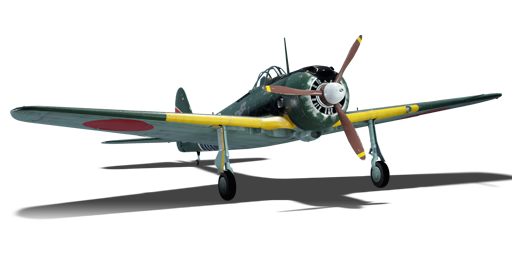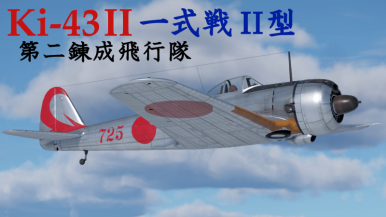

Aviation
Ki-43-II
I
Rank
AB
2.3
RB
2.7
SB
2.7
Battle rating
Japan
Research country
Fighter
Main role
3,000

Research
6,300

Purchase
General information
Flight performance
Max speed
at 6,000 m
558524581538 km/h
Rate of Climb
15.312.119.512.1 m/s
Turn time
1516.214.315.7 s
Max altitude
9,800 m
Takeoff Run
190 m
Landing
flaps
flaps
Take-off
flaps
flaps
Combat
flaps
flaps
Air
brake
brake
General characteristics
Crew
1 person
Engine
Length
8.9 m
Wingspan
10.8 m
Wing Loading
111 kg/m²
Weight:
Base weight
2.022.091.972.08 t
Fuel in main tanks
0.39 t (1h 22m)
Limits:
Max Speed Limit (IAS)
661 km/h
Mach Number Limit
0.65 M
G limit
≈ -8/11 G
Flap Speed Limit (IAS)
L / T / C
250 / 362 / 383 km/h
Gear Speed Limit (IAS)
300 km/h
Offensive armament
2 × 12.7 mm Ho-103 machine gun
Ammunition
500 rounds
Fire rate
900 shots/min
One-second Burst Mass
0.53 kg
| Belt | Belt filling | Armor penetration (mm) at a distance: | |||||
|---|---|---|---|---|---|---|---|
| 10 m | 100 m | 500 m | 1000 m | 1500 m | 2000 m | ||
| AP-T/AP/HEF-I | 21 | 19 | 13 | 7 | 4 | 3 | |
| AP-T/HEF-I/AP/HEF-I | 21 | 19 | 13 | 7 | 4 | 3 | |
| AP-T/HEF-I/HEF-I/HEF-I | 21 | 19 | 13 | 7 | 4 | 3 | |
| AP-T/AP/AP-T | 21 | 19 | 13 | 7 | 4 | 3 | |
| AP/HEF-I/HEF-I/HEF-I | 21 | 19 | 13 | 7 | 4 | 3 | |
Suspended armament
Setup 1
2 × 50 kg Army Type 94 GPHE bomb
Setup 2
2 × 100 kg Army Type 94 GPHE bomb
Setup 3
2 × 250 kg Army Type 92 GPHE bomb
Economy
Repair cost
Basic → Reference
AB
260 → 327 

RB
537 → 674 

SB
744 → 934 

Crew training
1,800 

Experts
6,300 

Aces
80 

Research Aces
135,000 

Reward multiplier
AB / RB / SB
20 / 40 / 90 % 

106 % 

Total cost of modifications
5,960 

4,520 

Talisman cost
410 

Research order:
Flight performance | |
|---|---|
Survivability |
|---|
Weaponry | |
|---|---|
Rating by players
You must play more than 3 battles for the last week and more than 10 battles in a vehicle to rate it.
Like:
34
Flight performance:
Not enough ratings
Survivability:
Not enough ratings
Aerial combat:
Not enough ratings
Ground attack:
Not enough ratings
Balance:
Not enough ratings
Tips & Tricks
This space is currently empty
Do you know any interesting vehicle features?
Loading...
No articles about this vehicle yet
Become the first author and get rewards!
Write a guide, tell about interesting historical facts, make a tutorial or simply an interesting post.
No more content
